Performance-installations at the Festspielhaus Hellerau
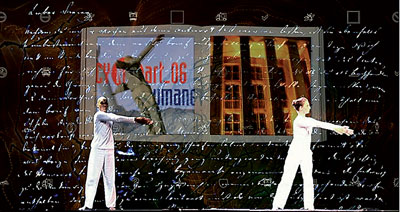
»PERFEKT HUMAN« MIKA SATOMI & HANNAH PERNER-WILSON
30th Oct. | 10pm
31st Oct. | 7pm
1st Nov. | 7pm
2008 -- http://www.kobakant.at | Concept and realization: Mika Satomi, Hannah Perner-Wilson | Performer: Ivana Kalc
Thanks to: Kunstuniversität Linz, Institute Interface Cultures, Ars Electronica Festival 2008
Perfect Human is a performance inspired by Joergen Leth's 1967 short film "The Perfect Human" and Lars von Trier's "The Five Obstructions" (2003). This performance intends to create a sixth obstruction, by introducing the rule of performance and the rule of non-linear narration.
The performance takes place in public space, using a motion-capture costume and portable radios. The technology worn by the performer plays the role of an interpreter, mapping statements to her bodily expressions. These statements are translated into spoken words, broadcast and played back through surrounding radios.
The performer copies the movements of the person inside the marked space. This allows the audience to explore the system through the mirroring of movement, moreover they have to themselves become involved in order to perform the role of the perfect human.
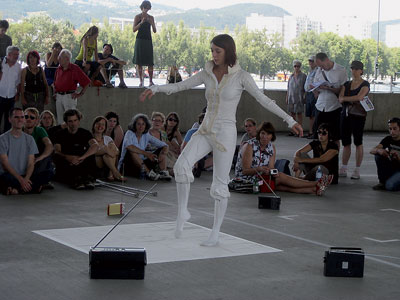
»PASSAGE« MARIE-CLAUDE POULIN & MARTIN KUSCH
30th Oct. | 10-12pm
31st Oct. | 11am-1pm, 5.30-6.30pm & 9.30-12pm
2007 -- http://www.konditionpluriel.org | a hybrid of interactive installation and performance |
artistic direction: Martin Kusch, Marie-Claude Poulin; choreography: Marie-Claude Poulin; contributions to movement research: Benoît Lachambre, Dominique Porte; media environment/visual performance: Martin Kusch; composition and sound performance: Alexandre St-Onge; dramaturgy: Armando Menicacci; dance/performance: Catherine Tardif; installation: Martin Kusch in collaboration with Éric Belley;, costumes: Linda Brunelle; lighting and technical direction: Éric Belley; sensor system: Technology Playgroup; max consultant: Alexandre Burton
with the support of: Canada Council for the Arts (CAC), Conseil des Arts et des Lettres du Québec (CALQ), Conseil des Arts de Montréal (CAM) sowie and Vertretung der Regierung von Québec, Berlin.
»passage« is a performance-installation project with one dancer, created by the performance production group kondition pluriel. It is a practical research into the possibilities created by blurring the boundaries between active performers and passive spectators, and exploring varying states of intimacy and proximity, with the goal of creating an artwork that oscillates between interactive installation and performance. The project incorporates dance performance, choreography, improvisation and a constantly evolving, dynamic and responsive media environment. This media platform is generated by continuous live input from multiple users - the spectators - via a series of wireless sensors attached and distributed both on the costume of a dancer/performer, and throughout the installation environment.
The mixed format of passage, an inbetween of interactive media design, dance performance and improvisation, creates a new model of dance-performance, which triggers social interaction, questions the spectator on his relationship to his own body, addresses his quality of listening and invites and stimulates the spectator to participate in a playful experience where he finds himself at once object and subject.
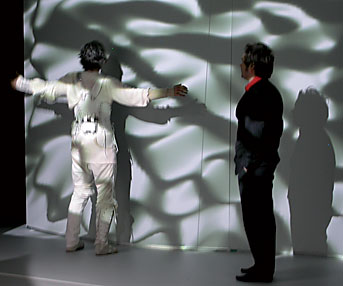
»RECHNENDER RAUM« RALF BAECKER
30th Oct. - 2nd Nov.
2007 -- http://www.no-surprises.de | Sculpture | Recognition
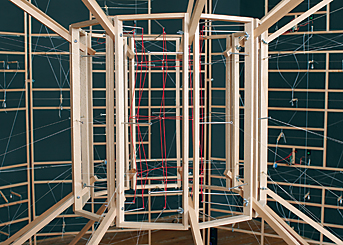 The inverted machine - Rechnender Raum (Calculating Space) is a light-weight sculpture, constructed from sticks, strings and little plumbs. At the same time it is a full functional logic exact neural network. Through its strict geometric and otherwise very filigree construction, the observer is able to track the whole processing logic from every viewpoint around the machine.
The inverted machine - Rechnender Raum (Calculating Space) is a light-weight sculpture, constructed from sticks, strings and little plumbs. At the same time it is a full functional logic exact neural network. Through its strict geometric and otherwise very filigree construction, the observer is able to track the whole processing logic from every viewpoint around the machine.»ÆS02 INTERIM CAMP« MARCUS WENDT & VERA-MARIA GLAHN
Post Me_New ID-Lounge
30th Oct. - 2nd Nov.
2008 -- http:// www.marcuswendt.com | Videoinstallation | CYNETart - Artist-in-Residence-Stipendium der Kunstministerin
Music: Arran Poole, Sound: Arran Poole
Poor visibility; weather again unsettled today. Surreal rocks and riven lowlands, valleys fog-shrouded. Frightening depths, and emptiness. Rarity of air is noticeable. What are you looking for in this hostile stretch?
An expedition into abstract generative landscapes.


»MUTARE« ALIM PASCHT-HAN
SeitenbĂĽhne Ost
30th Oct. - 2nd Nov.
2006 | Video Installation, Multi Channel Projection onto Glas Body, HDV, 36:00 min, Loop, Glas, Acrylic, Iron 100x100x210cm | recognition,
voice: Evgenia Grekova, actress: Henriette BlĂĽmenau
In MUTARE the sleep of a certain person has been fragmented. This includes the neurophysiological changes of a person during a dream. To gain visual data the cerebral activities of both known and unknown processes during the desynchronized sleep have been recorded. Those data has been splitted into four basic parts and allocated to four vessels. Theses vessels contain sights of fleshly transience, sexual deformation and self-determined addictions.
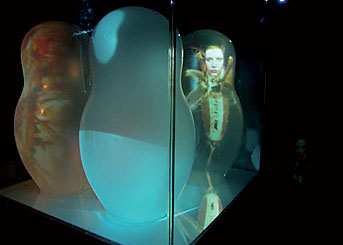
»LIDO« JAN-PETER E.R. SONNTAG
30th Oct. - 2nd Nov. | 6th - 8th Nov.
2008 -- http://www.sonarc-ion.de | HD-Videoprojektion I CYNETart-Preis der Stiftung für Kunst & Kultur der Stadtsparkasse Dresden | Sound/Vision/Komposition/Raum: Jan-Peter E.R. Sonntag; Software Programmierung: Thomas Plöntzke; Soundtechnische Assistenz: Harry Kügler; ©Jan-Peter E.R. Sonntag, N-solab
On the 10th of June at the Lido at 10.37am I shot that photo. It took round about 4 years from the beginning when I have started this work up to this right moment and it was a really fast shot of 3000th of second - a frozen moment now in an inner digital movement.
The TRISTAN(accord) is a big symbol for indissoluble, dissonant moment in transition - this accord is isolated. You hear the digital expanded ›harmony‹ on the piano at my appartment and a kind of increasing afterglow of the overtones up to the point where the four basic (sinus)tones just twiste inbetween the 2 channels which creates different interferrences and resonances in the space which surrounds the audience. This reduced and frozen form / moment creates a special psycho-acoustic status and allmost cinema as an unspoken language.
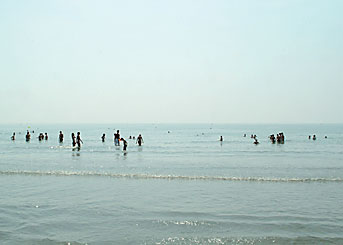
»[OSZO 24]TM - 4,2 MWH« - »[OSZO 25]TM - BEDA VENERABILIS« - »[OSZO 26]TM - TILL DEATH DO US PART« RITCHIE RIEDIGER
2008 -- http://www.oszo.de | installations
»[OSZO 24]TM« is a sensually impressive, hyper-lit corridor of 18 m² in size equipped with 400 neon lights that create a physical experience and transform space into an elevator into another dimension: promise and menace at the same time. In his piece »[OSZO 26]TM« Ritchie Riediger thematises nothing but the fundament of the artist's idealism and art itself. A self-portrait can hardly be more radical: With a digital clock ticking backwards Riediger completely rids the subject of its figurativeness, while the rapid countdown demonstrates his own lifetime still remaining. In »[OSZO 25]TM« the artist confronts his remaining years with the age of the world as it has been calculated in the Middle Ages, based on the Old Testament. The seconds are ticking forward and backward, the speed is intriguing.
The digital clock displaying the age of the world - almost 6000 years according to an old calculation - is connected to an atomic clock signal generated in Braunschweig. It displays the figures up to the thousandth part of a second.
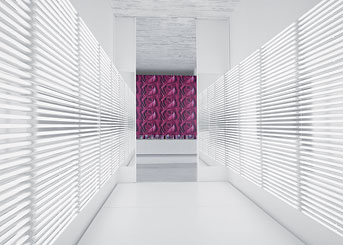
»TRAM.WAY PROJECT« MAKARUK & PANI K.
1st Nov. | 8pm
2008 -- http://www.makaruk.net | Audiovisual project of Makaruk - producer, programmer, live electronics
performer - and Pani K. - film producer and VJ.
In their project, Makaruk and Pani K. re-create a pre-recorded documentary movie live, along with performing music and sound effects. The concept of their performance is to create a "cinematic concert" that is half-arranged and half-improvised with fixed counterpoints. The sound layers and visuals are connected through hardware creating a mutually dependent entity. Live capture technology will be used during the performance in order to transform the images live. The performers also use a light-sensitive sensory installation to control the visuals and the sound generated by their specifically programmed Max/MSP software.
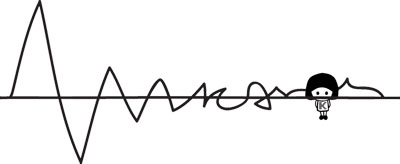
»MUSIC OF LIFE« MUSIC&SCIENCE-PROJECT OF THE GROUP OF ARTISTS PI-XL
2008 -- http://www.pixelsex.org/musicoflife/
»Music of life« is a music&science project of the Pi-XL group. For the first time the models of cellular automata used in biomathematics are taken to generate an interactive music based on the human voice. This opens up new ways for a performative composition!
The »Music of Life« functions similar to a laola wave in a stadium with moving sounds from singer to singer. There is neither a director nor a score, but the development is driven by simple local rules how to react on the neighbours. So for this space time related live composition it is relevant to react on and LISTEN to the neighbours in the choir group.
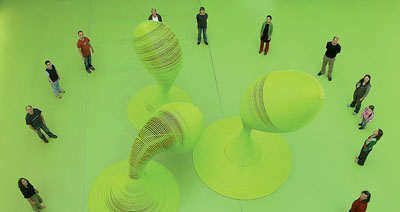
»CAMERA ORFEO« PENELOPE WEHRLI
6th Nov. | 8-11pm, 7th Nov. | 8pm-1am, 8th Nov. | 7-10pm
2008 -- http://www.aether1.org | An auto-choreographic media composition by Penelope Wehrli
Musikalisches Konzept/Klangraum: Sam Auinger; Technische Leitung/Maschinenentwicklung/Bau: Peter Buchheit; Stimme/Tanz: Rickie Eden; Audiosoftware: Joa Glasstetter; Produktionsleitung: Anke Hoffmann; KostĂĽm: Ellen Hofmann; Musikalisches Konzept: katrinem; Kamera/Bildbearbeitung: Sirko KnĂĽpfer; Barockensemble: Lauttencompagney Berlin; Motion-Tracking/Video Software: Dominik Rinnhofer; Assistenz Sound Live-Feed: Daniel Scheffler; Dramaturgische Beratung: Detlev Schneider; Konzept/Raum/Inszenierung: Penelope Wehrli; Assistenz Inszenierung: Nele Wohlatz
Gefördert aus Mitteln des Hauptstadtkulturfonds, der Schering Stiftung, des Bundesamtes für Kultur, Schweiz. Eine Produktion von peninsula.ink in Kooperation mit der Trans-Media-Akademie Hellerau e.V. Diese Veranstaltung wird ermöglicht durch das NATIONALE PERFORMANCE NETZ aus Mitteln der Beauftragten der Bundesregierung für Kultur und Medien sowie der Kultur- und Kunstministerien der Länder.
Orpheus leads Eurydice up from the underworld. He is not allowed to look back at her. But he turns around and Eurydice disappears like a dissolving image.
Memory is an active process in which existing information is newly defined for the respective acute context. Remembered images do not describe the past, but rather the present.
Orpheus must turn around in order to constantly re-invent Eurydice.
If he had not looked at her, he would not have drawn her to him, and no doubt she is not there, but he himself is absent in his glance. (Maurice Blanchot, „The Gaze of Orpheus")
camera orfeo is a spatially expansive auto-choreographic installation that is made up of numerous parallel, partially linked threads: Monteverdi's „Possente Spirito"/„Orfeo son Io" (9:00), re-edited; moving spatial modules; video projections of a dancer; an endoscopic recording of vocal cords and words from an archive; and the exterior space (live feed of video and sound). Monteverdi's aria and a short movement succession on video performed by the dancer Junko Wada are cut in sequences and various variations saved in a databank. The audience moves freely within an installation whose spatial modules are in constant motion. The music can be heard from the speakers; some of these are also moving. Via camera tracking the visitors' movement causes signals to be sent, though they don't perceive this directly. Specific music or video sequences are thus activated which can then,
in extension, create other levels of images. There will always suddenly be moments when, as a result of spatial constellations, the flow of images and sound that surrounds the performance site will dominate the interior space via a live video and sound feed, and thus erasing Eurydice's projected image. For a determined time period the sensors then remain switched off before they can be reactivated.
»camera orfeo« is an attempt to transfer the neuronal process of remembering, which is simultaneously a process of new definition and erasure, onto a space. Individual visitors will be confronted with constantly changing new musical and spatially choreographed constellations and contexts as permutations of the given material. Their process of listening and observing will therefore be subsumed under a constant process of remembering. The loop-like character, which is already present in the musical structure of the aria, seems to be endless; but the material is limited. It is used up by the visitors. Their movements determine the end as well as the beginning of the piece. Each performance is unique. »camera orfeo« is a poetically circular system, a microscopic kaleidoscope for images, sound and movement. The piece will have a performance and an installation modus.
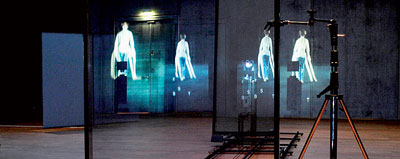
»AUTOMATIQUE CLUBBING«
8th Nov. | 10pm
Software-Engineering: Jacob Korn, Matthias Härtig, Frieder Weiß; Tracking systems: EyeCon, Kalypso (hypecycle.de); Music: Benjamin Brunn, Jacob Korn; visual design: Matthias Härtig; Concept: DS-X.org
»automatique clubbing« is produced by Trans-Media-Laboratory Hellerau in co-operation with Frieder Weiß and DS-X.org
The conventional boundaries between VJ, musician and the audience have become part of the past. Nowadays integral software engineering builds the interface between auditory and visual space to create a very special synaesthetic experience. The project aims at satisfying an intensified involvement of the body as well as the audience's desire to participate in the creation of the music and in the interaction with the musician. Based on a network the audience will be offered controllable effect parameters for the music. Visual shapes, shadows as well as graphic meeting points will be the playground of the dancers on the dance floor. EyeCon and Kalypso will be in top form. If you are, too, this virtually ›sensitive space‹ will go along with you through the night, all "automatiquely" ...
JACOB KORN
live AV-set (running back, left of the dial - dresden)
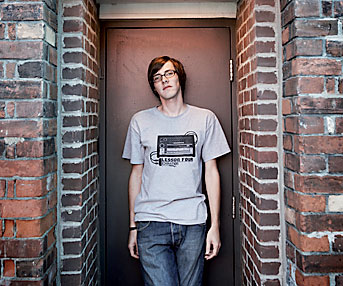 What to expect from this night, is a live trip to the world of music that Jacob currently works on: Deepest Cosmic Disco, Detroit and Chicago Acid House at its best. Carl Craig has given his O.K., Prins Thomas will remix his stuff, and the launches of his next records are marked in the calendars of ›Running Back‹ and John Kong's Label ›Left Of The Dial‹, right after the ones by Alton Miller, K Alexi and Basic Soul Unit.
What to expect from this night, is a live trip to the world of music that Jacob currently works on: Deepest Cosmic Disco, Detroit and Chicago Acid House at its best. Carl Craig has given his O.K., Prins Thomas will remix his stuff, and the launches of his next records are marked in the calendars of ›Running Back‹ and John Kong's Label ›Left Of The Dial‹, right after the ones by Alton Miller, K Alexi and Basic Soul Unit.BENJAMIN BRUNN
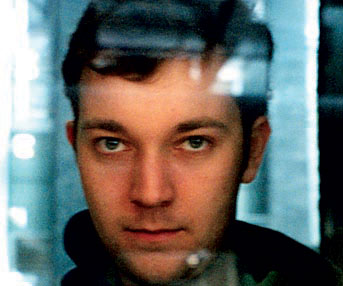 In 1996 Brunn started to make music with his KORG X3 workstation. Two years later the label Hardwax in Dresden released his first tracks. Through these tracks he also encountered Lowtec from ›United States of Mars/Workshop‹ and Mathias Schaffhäuser from ›Ware-Records‹ . Those labels still sell his music up to the present day. He has been part of the artist crew at ›Binemusic‹ since 2004. Most of his music is based on a synthesis and the sound of the Nord Modular - a virtual-analogue synthesizer that has been an inherent part of his equipment for performances since 1999.
In 1996 Brunn started to make music with his KORG X3 workstation. Two years later the label Hardwax in Dresden released his first tracks. Through these tracks he also encountered Lowtec from ›United States of Mars/Workshop‹ and Mathias Schaffhäuser from ›Ware-Records‹ . Those labels still sell his music up to the present day. He has been part of the artist crew at ›Binemusic‹ since 2004. Most of his music is based on a synthesis and the sound of the Nord Modular - a virtual-analogue synthesizer that has been an inherent part of his equipment for performances since 1999.